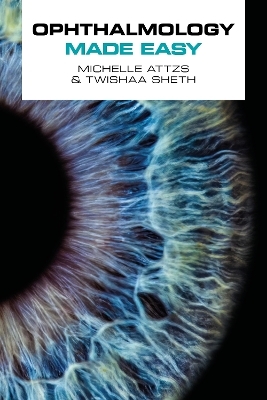
Ophthalmology Made Easy
Scion Publishing Ltd (Verlag)
978-1-914961-37-3 (ISBN)
Eye emergencies may present in the GP surgery, A&E or an outpatient clinic, but few people outside of ophthalmology are confident about the management of eye problems. This book will give you the essential skills to:
perform an initial assessment
understand what you can manage yourself and how to do the basics
decide when you need to refer to ophthalmology.
In addition, the book provides:
a glossary of common ophthalmic terminology and medications which will be invaluable when reviewing ophthalmology letters
a triage ready reckoner to help you sort the symptoms and decide how quickly you need to refer
a systems-based approach to highlight common conditions and then describes how to assess, investigate and manage each of them
a guide to the most common investigations and how to interpret the results.
At all stages, symbols are used to highlight what can safely be undertaken in general practice and A&E, and when ophthalmologists should take over. Red flag boxes highlight important clinical concepts that should never be missed, and red text is used to indicate sight- or life-threatening conditions.
This is a book to help anyone looking to refresh their knowledge of diagnosis, management and referral to ophthalmology: medical students, foundation doctors, GPs, A&E doctors, junior ophthalmology specialty trainees, ophthalmic nurses and nurse practitioners.
1 Basic ophthalmic history
1.1 Introduction
1.2 History of presenting complaint
1.3 Systems review
1.4 Background history
2 Basic ophthalmic anatomy and examination
2.1 Introduction
2.2 Assessment of visual function
2.3 Orbit
2.4 Adnexal structures
2.5 Conjunctiva and cornea
2.6 Sclera
2.7 Anterior chamber and iridocorneal angle
2.8 Iris and pupil
2.9 Lens
2.10 Posterior segment
3 Common terminology and abbreviations used in an ophthalmological report
3.1 Introduction
3.2 Common terms
4 Common ophthalmic medications
4.1 Introduction
4.2 Key medications and their indications
4.3 Combination glaucoma drops
4.4 Dry eyes drops/lubricating eye drops
4.5 Other combination ocular medications
5 Focusing your history: sorting the symptoms
5.1 Introduction
5.2 Red eye
5.3 Acute loss of vision
5.4 Flashes and floaters
5.5 Swollen lids
5.6 Headaches with ringing in the ears (tinnitus) and visual obscuration
5.7 Transient monocular vision loss
6 Triage ready reckoner
7 The orbit
7.1 Introduction
7.2 What might an orbital condition look like?
7.3 What are the causes of an orbital presentation?
7.4 Orbital presentations you need to understand
8 Lashes, lids and lacrimal apparatus
LASHES
8.1 Lash malposition
8.2 Blepharitis
LIDS
8.3 Lid malposition
8.4 Lid lumps
8.5 Lid lesions & malignant
8.6 Lid lesions & benign
LACRIMAL APPARATUS
8.7 Epiphora
9 Conjunctiva, cornea and sclera
9.1 Introduction
9.2 Dry eye disease
9.3 Conjunctiva
9.4 Corneal ulcers
9.5 Peripheral corneal disease
9.6 Corneal graft
9.7 Corneal dystrophies
9.8 Scleritis
10 Anterior chamber and iridocorneal angle
10.1 Introduction
10.2 Uveitis
11 Lens
11.1 Introduction
11.2 Cataract
11.3 Pre-operative checks for the ophthalmologist
11.4 Post-operative checks for the ophthalmologist
11.5 Post-operative endophthalmitis
11.6 Post-operative considerations for the non-ophthalmologist
12 Medical retina
12.1 Introduction
12.2 Investigation of retinal disease: electrodiagnostic testing
12.3 Age-related macular degeneration
12.4 Retinopathy associated with systemic disease
12.5 Vascular occlusion
12.6 Inherited retinal dystrophies
12.7 Ocular oncology
13 Vitreoretinal
13.1 Introduction
13.2 Acute presentations
13.3 Chronic presentations
14 Neuro-ophthalmology
14.1 Introduction
14.2 Basic visual pathway anatomy
14.3 Neuro-ophthalmology examination
14.4 Headache
14.5 Blurred vision
14.6 Diplopia
14.7 Anisocoria
14.8 Visual field defects
15 Paediatric ophthalmology
15.1 Introduction
15.2 Paediatric history and examination
15.3 Common paediatric conditions
16 Trauma
16.1 Introduction
16.2 Trauma history and examination
16.3 Lid laceration
16.4 Chemical injury
16.5 Thermal injury
16.6 Orbital fractures
16.7 Globe injuries
16.8 Non-accidental injury in children
17 Visual fields
17.1 What is a visual field test and why do we use it?
17.2 The visual field
17.3 Types of visual field test
17.4 Common terms in visual field testing
17.5 Interpreting visual field tests
18 Ocular coherence tomography
18.1 What is ocular coherence tomography and why do we use it?
18.2 What types of OCT are there?
18.3 Macular OCT
19 Ocular ultrasound
19.1 What is an ocular ultrasound and why do we use it?
19.2 Performing an ocular ultrasound
19.3 Interpreting an ocular ultrasound
20 FFA
20.1 What is FFA and why do we use it?
20.2 Performing an FFA
20.3 Phases of FFA
20.4 Interpretation of FFA
21 Systemic inflammation
21.1 Introduction
22 Systemic infection
22.1 Introduction
22.2 Conjunctivitis
22.3 Keratitis
22.4 Scleritis
22.5 Uveitis
22.6 Endophthalmitis
22.7 Retinal signs of systemic infection
Appendix 1: Snellen chart
Appendix 2: Jaeger near vision chart
| Erscheinungsdatum | 06.02.2024 |
|---|---|
| Verlagsort | Bloxham |
| Sprache | englisch |
| Maße | 156 x 234 mm |
| Gewicht | 605 g |
| Themenwelt | Medizin / Pharmazie ► Medizinische Fachgebiete ► Augenheilkunde |
| ISBN-10 | 1-914961-37-4 / 1914961374 |
| ISBN-13 | 978-1-914961-37-3 / 9781914961373 |
| Zustand | Neuware |
| Haben Sie eine Frage zum Produkt? |
aus dem Bereich


